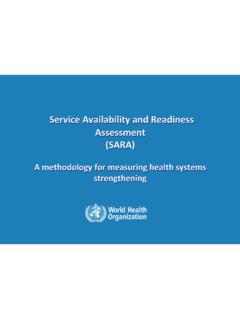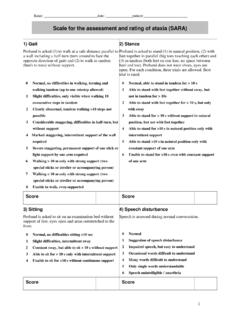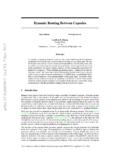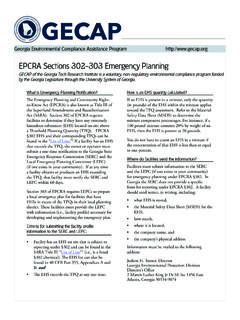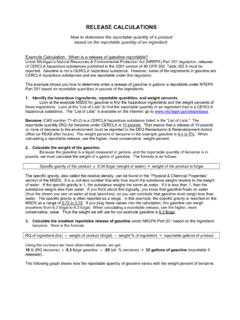Transcription of U.S. ENVIRONMENTAL PROTECTION AGENCY SPCC FIELD …
1 Onshore Facilities (Excluding Oil Production) Page 1 of 14 June 2014 ENVIRONMENTAL PROTECTION AGENCY SPCC FIELD INSPECTION AND PLAN REVIEW CHECKLIST ONSHORE FACILITIES (EXCLUDING OIL DRILLING, PRODUCTION AND WORKOVER) Overview of the Checklist This checklist is designed to assist EPA inspectors in conducting a thorough and nationally consistent inspection of a facility s compliance with the Spill Prevention, Control, and Countermeasure (SPCC) rule at 40 CFR part 112. It is a required tool to help federal inspectors (or their contractors) record observations for the site inspection and review of the SPCC Plan. While the checklist is meant to be comprehensive, the inspector should always refer to the SPCC rule in its entirety, the SPCC Regional Inspector Guidance Document, and other relevant guidance for evaluating compliance. This checklist must be completed in order for an inspection to count toward an AGENCY measure ( , OEM inspection measures or GPRA).
2 The completed checklist and supporting documentation ( photo logs or additional notes) serve as the inspection report. This checklist addresses requirements for onshore facilities including Tier II Qualified Facilities (excluding facilities involved in oil drilling, production and workover activities) that meet the eligibility criteria set forth in (g)(2). Separate standalone checklists address requirements for: Onshore oil drilling, production, and workover facilities including Tier II Qualified Facilities as defined in (g)(2); Offshore drilling, production and workover facilities; and Tier I Qualified Facilities (for facilities that meet the eligibility criteria defined in (g)(1)) Qualified facilities must meet the rule requirements in and other applicable sections specified in , except for deviations that provide ENVIRONMENTAL equivalence and secondary containment impracticability determinations as allowed under The checklist is organized according to the SPCC rule.
3 Each item in the checklist identifies the relevant section and paragraph in 40 CFR part 112 where that requirement is stated. Sections through specify the applicability of the rule and requirements for the preparation, implementation, and amendment of SPCC Plans. For these sections, the checklist includes data fields to be completed, as well as several questions with yes, no or NA answers. Section includes requirements for qualified facilities. These provisions are addressed in Attachment D. Section includes general requirements that apply to all facilities (unless otherwise excluded). Sections and specify requirements for spill prevention, control, and countermeasures for onshore facilities (excluding production facilities). The inspector needs to evaluate whether the requirement is addressed adequately or inadequately in the SPCC Plan and whether it is implemented adequately in the FIELD (either by FIELD observation or record review).
4 For the SPCC Plan and implementation in the FIELD , if a requirement is addressed adequately, mark the Yes box in the appropriate column. If a requirement is not addressed adequately, mark the No box. If a requirement does not apply to the particular facility or the question asked is not appropriate for the facility, mark as NA . Discrepancies or descriptions of inspector interpretation of No vs. NA may be documented in the comments box subsequent to each section. If a provision of the rule applies only to the SPCC Plan, the FIELD column is shaded. Space is provided throughout the checklist to record comments. Additional space is available as Attachment E at the end of the checklist. Comments should remain factual and support the evaluation of compliance. Attachments Attachment A is for recording information about containers and other locations at the facility that require secondary containment.
5 Attachment B is a checklist for documentation of the tests and inspections the facility operator is required to keep with the SPCC Plan. Attachment C is a checklist for oil spill contingency plans following 40 CFR 109. Unless a facility has submitted a Facility Response Plan (FRP) under 40 CFR , a contingency plan following 40 CFR 109 is required if a facility determines that secondary containment is impracticable as provided in 40 CFR (d). The same requirement for an oil spill contingency plan applies to the owner or operator of a facility with qualified oil-filled operational equipment that chooses to implement alternative requirements instead of general secondary containment requirements as provided in 40 CFR (k). Attachment D is a checklist for Tier II Qualified Facilities. Attachment E is for recording additional comments or notes. Attachment F is for recording information about photos.
6 Onshore Facilities (Excluding Oil Production) Page 2 of 14 June 2014 FACILITY INFORMATION FACILITY NAME: LATITUDE: LONGITUDE: GPS DATUM: Section/Township/Range: FRS#/OIL DATABASE ID: ICIS#: ADDRESS: CITY: STATE: ZIP: COUNTY: MAILING ADDRESS (IF DIFFERENT FROM FACILITY ADDRESS IF NOT, PRINT SAME ): CITY: STATE: ZIP: COUNTY: TELEPHONE: FACILITY CONTACT NAME/TITLE: OWNER NAME: OWNER ADDRESS: CITY: STATE: ZIP: COUNTY: TELEPHONE: FAX: EMAIL: FACILITY OPERATOR NAME (IF DIFFERENT FROM OWNER IF NOT, PRINT SAME ): OPERATOR ADDRESS: CITY: STATE: ZIP.
7 COUNTY: TELEPHONE: OPERATOR CONTACT NAME/TITLE: FACILITY TYPE: NAICS CODE: HOURS PER DAY FACILITY ATTENDED: TOTAL FACILITY CAPACITY: TYPE(S) OF OIL STORED: LOCATED IN INDIAN COUNTRY? YES NO RESERVATION NAME: INSPECTION/PLAN REVIEW INFORMATION PLAN REVIEW DATE: REVIEWER NAME: INSPECTION DATE: TIME: ACTIVITY ID NO: LEAD INSPECTOR: OTHER INSPECTOR(S): INSPECTION ACKNOWLEDGMENT I performed an SPCC inspection at the facility specified above. INSPECTOR SIGNATURE: DATE: SUPERVISOR REVIEW/SIGNATURE: DATE: Onshore Facilities (Excluding Oil Production) Page 3 of 14 June 2014 SPCC GENERAL APPLICABILITY 40 CFR IS THE FACILITY REGULATED UNDER 40 CFR part 112?
8 The completely buried oil storage capacity is over 42,000 gallons, OR the aggregate aboveground oil storage capacity is over 1,320 gallons AND The facility is a non-transportation-related facility engaged in drilling, producing, gathering, storing, processing, refining, transferring, distributing, using, or consuming oil and oil products, which due to its location could reasonably be expected to discharge oil into or upon the navigable waters of the United States Yes No Yes No AFFECTED WATERWAY(S): DISTANCE: FLOW PATH TO WATERWAY: Note: The following storage capacity is not considered in determining applicability of SPCC requirements: Equipment subject to the authority of the Department of Transportation, Department of the Interior, or Minerals Management Service, as defined in Memoranda of Understanding dated November 24, 1971, and November 8, 1993; Tank trucks that return to an otherwise regulated facility that contain only residual amounts of oil (EPA Policy letter) Completely buried tanks subject to all the technical requirements of 40 CFR part 280 or a state program approved under 40 CFR part 281; Underground oil storage tanks deferred under 40 CFR part 280 that supply emergency diesel generators at a nuclear power generation facility licensed by the Nuclear Regulatory Commission (NRC) and subject to any NRC provision regarding design and quality criteria, including but not limited to CFR part 50.
9 Any facility or part thereof used exclusively for wastewater treatment (production, recovery or recycling of oil is not considered wastewater treatment); (This does not include other oil containers located at a wastewater treatment facility, such as generator tanks or transformers) Containers smaller than 55 gallons; Permanently closed containers (as defined in ); Motive power containers(as defined in ); Hot-mix asphalt or any hot-mix asphalt containers; Heating oil containers used solely at a single-family residence; Pesticide application equipment and related mix containers; Any milk and milk product container and associated piping and appurtenances; and Intra-facility gathering lines subject to the regulatory requirements of 49 CFR part 192 or 195. Does the facility have an SPCC Plan? Yes No FACILITY RESPONSE PLAN (FRP) APPLICABILITY 40 CFR (f) A non-transportation related onshore facility is required to prepare and implement an FRP as outlined in 40 CFR if: The facility transfers oil over water to or from vessels and has a total oil storage capacity greater than or equal to 42,000 gallons, OR The facility has a total oil storage capacity of at least 1 million gallons, AND at least one of the following is true: The facility does not have secondary containment sufficiently large to contain the capacity of the largest aboveground tank plus sufficient freeboard for precipitation.
10 The facility is located at a distance such that a discharge could cause injury to fish and wildlife and sensitive environments. The facility is located such that a discharge would shut down a public drinking water intake. The facility has had a reportable discharge greater than or equal to 10,000 gallons in the past 5 years. Facility has FRP: Yes No NA FRP Number: Facility has a completed and signed copy of Appendix C, Attachment C-II, Certification of the Applicability of the Substantial Harm Criteria. Yes No Comments: Onshore Facilities (Excluding Oil Production) Page 4 of 14 June 2014 1 Oil discharges that result from natural disasters, acts of war, or terrorism are not included in this determination. The gallon amount(s) specified (either 1,000 or 42) refers to the amount of oil that actually reaches navigable waters or adjoining shorelines not the total amount of oil spilled.











